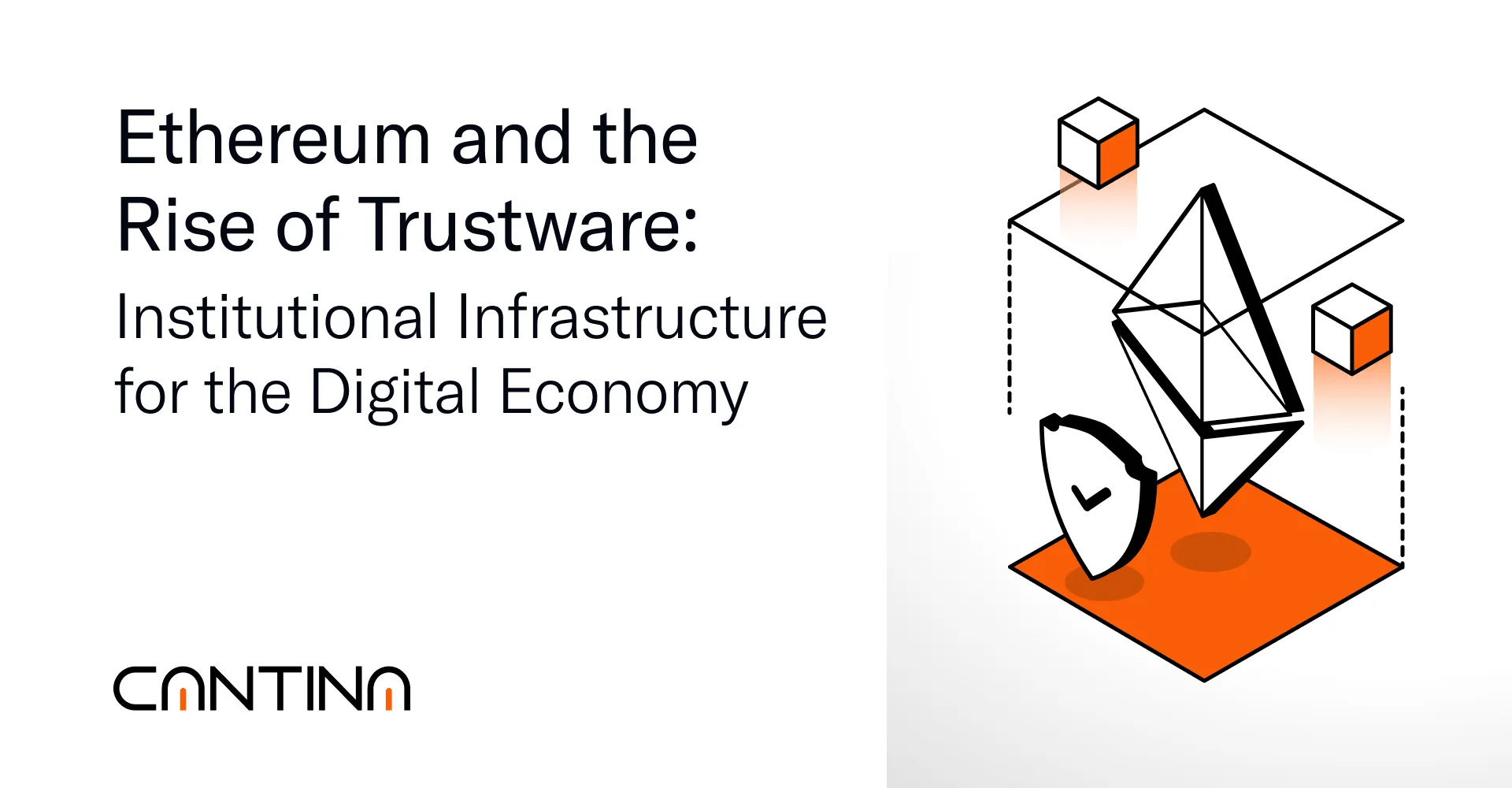Introduction
Ethereum has evolved into the foundational infrastructure for a trust-based digital economy. As institutions shift capital, assets, and operational workflows into programmable environments, they require systems that can offer security, auditability, and verifiable coordination. Trustware introduces a technical category designed to meet these expectations. It embeds finality and validity directly into protocol logic, replacing the need for legacy intermediaries with scalable, cryptographic trust.
This framing is particularly relevant for institutions evaluating where to build, invest, and integrate. Ethereum now secures over 60% of all stablecoins, hosts the deepest liquidity in decentralized finance, and supports the majority of tokenized real-world assets. These metrics reflect a maturing network that meets the core requirements of institutional infrastructure: verifiability, resilience, and global neutrality.
Trustware: Encoding Trust at the Infrastructure Layer
Trustware refers to systems that industrialize the production of trust through code. Ethereum’s design enables programmable rules, irreversible settlement, and protocol-enforced logic to deliver the assurances traditionally maintained by legal contracts, insurers.
Trust in this context is no longer a legal assumption or third-party function. It becomes a property of the system itself. Validity ensures that every transaction conforms to agreed logic. Finality guarantees the permanence of that logic once executed. Ethereum operationalizes both with mathematical certainty.
The global economy spends an estimated nine trillion dollars annually on systems designed to establish and maintain trust. Trustware infrastructure offers a more resilient and scalable alternative. Ethereum delivers those assurances at near-zero marginal cost, in real time, and without continuous human supervision.
Why Institutions Are Watching Ethereum Closely
Ethereum now supports the majority of tokenized financial infrastructure outside of Bitcoin. The network underpins:
- Over 60% of all stablecoins
- Roughly 60% of DeFi capital
- 80% of tokenized real-world assets
Its validator base exceeds one million across more than 80 countries. Upgrades such as The Merge and Dencun have demonstrated operational continuity during protocol-scale transitions. The Ethereum Virtual Machine remains the dominant development environment, and all major tokenized asset providers utilize Ethereum as their primary platform.
Institutional actors including JPMorgan, BlackRock, Visa, and Franklin Templeton have already initiated deployments using Ethereum rails. These integrations represent alignment with a platform offering the infrastructure qualities required to support long-term asset management, payment processing, and financial coordination.
Strategic Value of ETH for Institutional Portfolios
ETH represents ownership of infrastructure capacity in the digital economy. It is spendable for execution, acts as collateral in DeFi, secures the protocol through staking, and accrues value as platform usage grows.
Unlike traditional assets, ETH combines utility with platform exposure. It enables participation in the system while serving as a yield-generating asset. Its performance is directly correlated with the expansion of Ethereum-based economic activity, including the growth of stablecoins, tokenized assets, and enterprise-grade deployments.
Implications for Infrastructure Developers
Organizations building within Ethereum’s ecosystem must demonstrate that their systems meet the same resilience, transparency, and security standards expected in traditional markets. This includes:
- High-signal security reviews of token logic, custody structures, and upgrade systems
- Simulation of failure scenarios including oracle inconsistencies, control path degradation, and congestion under stress
- Governance design assessments focused on role boundaries, proposal logic, and administrative clarity
- Documentation frameworks that support internal compliance, investor reporting, and regulatory disclosure
Cantina engages across these areas. Our approach supports long-term alignment between protocol architecture and institutional readiness.
Web3SOC and Infrastructure Maturity Signaling
Institutional actors need clarity when evaluating DeFi organizations. Web3SOC, developed by Cantina in collaboration with industry leaders, offers a structured classification framework to assess operational, financial, security, and regulatory maturity.
Organizations receive a confidential or public score reflecting their institutional posture. Web3SOC integrates with internal diligence workflows, enabling institutions to benchmark risk, allocate capital, and track progress across critical domains.
Organizations benefit by understanding where gaps remain and how to progress toward enterprise-grade performance. High scores signal preparedness for regulated market entry and institutional partnerships.
Conclusion
Ethereum represents the consolidation of digital trust into scalable infrastructure. It provides a path for institutions to engage in programmable, resilient, and globally distributed finance. As interest accelerates, organizations must prepare their systems to match the demands of institutional scrutiny.
Cantina supports that alignment by offering structured technical reviews, infrastructure maturity assessments, and direct support through Web3SOC. If your organization is preparing to integrate or operate within Ethereum’s trust layer, we can help.
Contact us to assess your infrastructure’s readiness for institutional standards.




